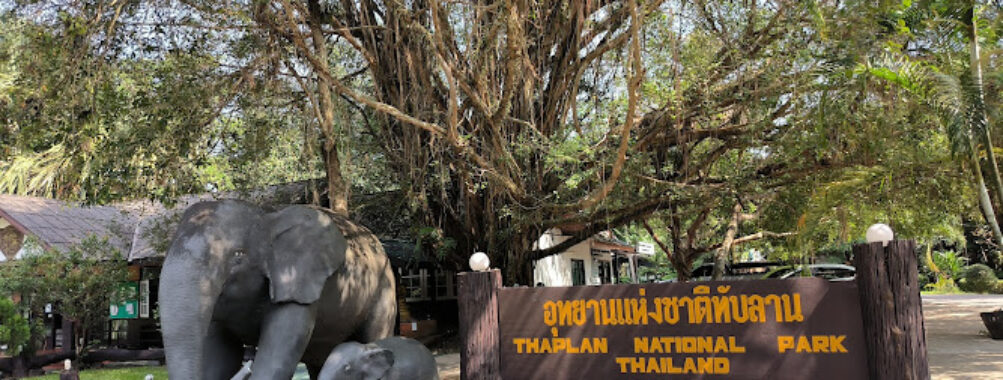
Thap Lan National Park
Table of Contents
Description
Thap Lan National Park is the kind of place that makes you feel small—in the best possible way. Stretching out over 2,240 square kilometers, it’s Thailand’s second-largest national park, and you can tell. The air here feels different, a little heavier with the scent of damp earth and wildflowers, and the sounds are a mix of rushing waterfalls, rustling leaves, and the occasional call of a hornbill. It’s not one of those parks that’s been overly polished for tourists either—you’ll still find raw edges, muddy trails after a storm, and stretches of forest where it feels like no one’s been in weeks. That’s part of the charm.
It’s a park of contrasts. One moment you’re walking through dense evergreen forest, the next you’re standing in an open meadow dotted with bright yellow blossoms (if you come between April and June, the Lan flowers are a real treat). Waterfalls tumble down mossy rocks, some easy to reach, others requiring a bit of a hike. And while there are plenty of family-friendly spots—picnic areas, kid-friendly trails, and even wheelchair-accessible facilities—there’s also a wildness here that keeps you on your toes. You might spot a deer grazing in the distance or hear the crack of branches that means something bigger is moving nearby.
Of course, not every inch of the park is perfect. Some trails can get overgrown, and during the rainy season, leeches are a real thing (pack the salt). But these quirks make it feel authentic, like you’re stepping into nature’s home rather than a curated attraction. If you’re the kind of traveler who likes your adventures with a side of unpredictability, this place will speak to you.
Key Features
- Expansive area covering 2,240 square kilometers across multiple provinces
- Rich biodiversity with rare birds, wild elephants, and lush evergreen forests
- Seasonal Lan flower blooms from April to June
- Multiple waterfalls, from easy-access spots to remote cascades
- Wheelchair-accessible entrances and parking
- Family-friendly facilities including picnic tables and public restrooms
- Hiking trails for all skill levels, including kid-friendly routes
- Opportunities for wildlife spotting and birdwatching
- Quiet picnic areas for a relaxed day out
Best Time to Visit
Choosing when to visit Thap Lan depends on what you’re after. If you want to see the Lan flowers in full bloom, aim for April to June—though be warned, it can get pretty warm. The cool season, roughly November to February, is my personal favorite. The air feels crisp, the skies are clearer, and hiking is a lot more pleasant without the sticky heat. The waterfalls are still flowing nicely after the rains, but the paths are drier and easier to navigate.
The rainy season, from May to October, has its own appeal. The forest turns into a lush, almost cinematic green, and the waterfalls are at their most dramatic. But you’ll need to be okay with mud, leeches, and the occasional trail closure. If you’re not a fan of slippery hikes, steer clear of the peak monsoon months.
How to Get There
Thap Lan National Park straddles several provinces, including Prachin Buri, Nakhon Ratchasima, and Buriram, which means you’ve got a few options for getting there. If you’re coming from Bangkok, it’s about a 3–4 hour drive depending on traffic and which entrance you’re aiming for. Public transport is possible but a bit of a patchwork—usually a bus to the nearest town, then a songthaew or taxi to the park gates. Honestly, renting a car or joining a guided tour makes life a lot easier, especially if you want to explore multiple parts of the park in one trip.
Some travelers like to combine a visit here with nearby Khao Yai National Park, making a loop through the region. If you’re doing that, plan your route in advance—cell service can be spotty in some stretches, and those winding mountain roads can be slow going.
Tips for Visiting
First things first—bring more water than you think you’ll need. The trails can be longer and more humid than they look on a map. And if you’re planning to hike, sturdy shoes are a must. I once made the mistake of wearing lightweight sneakers after a rainstorm, and let’s just say I spent the rest of the day squelching around with soggy socks.
Here are a few more tips to make your visit smoother:
- Start early in the day to avoid the midday heat and catch more wildlife activity.
- Pack insect repellent and, if visiting in the rainy season, leech socks or salt.
- Keep noise to a minimum on trails—your chances of spotting wildlife go way up.
- Check with park staff about trail conditions before heading out, especially after heavy rain.
- Respect the park’s rules—illegal logging and poaching are real issues here, and the rangers work hard to protect the area.
- Bring snacks or a picnic, but make sure to pack out all your trash. Monkeys can be sneaky thieves, so keep food sealed.
- If traveling with kids, stick to the designated family-friendly trails and picnic areas.
- In the dry season, carry a hat and sunscreen; shade isn’t guaranteed on every trail.
And finally—don’t try to see it all in one day. Thap Lan is huge, and rushing through it will only leave you tired and cranky. Pick a section or two, take your time, and let the park surprise you. That’s when the magic happens.
Location
Places to Stay Near Thap Lan National Park
Find and Book a Tour
Explore More Travel Guides
No reviews found! Be the first to review!